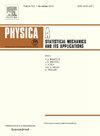Fluctuation-variable correlation as early warning signals of non-equilibrium critical transitions
IF 2.8
3区 物理与天体物理
Q2 PHYSICS, MULTIDISCIPLINARY
Physica A: Statistical Mechanics and its Applications
Pub Date : 2025-01-27
DOI:10.1016/j.physa.2025.130401
引用次数: 0
Abstract
Complex systems exhibit critical transitions, where the system shifts to a new and radically different state due to external or internal influences. Numerous studies have suggested some indicators to detect the early warning signal of critical transition (tipping point). Nonetheless, these indicators are typically formulated using fixed dynamical models or seldom considered in non-equilibrium natural systems. In this article, we propose a novel indicator, the maximum amplitude , based on the fluctuation-variable correlation. By performing temporal correlation with non-equilibrium dynamic effects and analyzing persistence behavior of dynamics, our findings reveal that increases abruptly and exhibits a peak value that serves as an early warning signal for the impending critical transition. We demonstrate that is a reliable and robust early warning signal by employing three models that presented different types of bifurcations. Additionally, results show that has higher sensitivity and specificity than lag-1 autocorrelation and variance. The indicator also provides early warning signals from the precipitation regime shift event time series of Houston in 2020–2021. Our study contributes to identifying potential critical transitions in natural systems, as well as assisting individuals in better preparing for and avoiding adverse transitions.
求助全文
约1分钟内获得全文
求助全文
来源期刊
CiteScore
7.20
自引率
9.10%
发文量
852
审稿时长
6.6 months
期刊介绍:
Physica A: Statistical Mechanics and its Applications
Recognized by the European Physical Society
Physica A publishes research in the field of statistical mechanics and its applications.
Statistical mechanics sets out to explain the behaviour of macroscopic systems by studying the statistical properties of their microscopic constituents.
Applications of the techniques of statistical mechanics are widespread, and include: applications to physical systems such as solids, liquids and gases; applications to chemical and biological systems (colloids, interfaces, complex fluids, polymers and biopolymers, cell physics); and other interdisciplinary applications to for instance biological, economical and sociological systems.

 求助内容:
求助内容: 应助结果提醒方式:
应助结果提醒方式:


